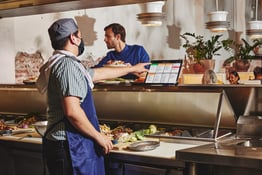The dishwasher is well known as one of the most repetitive and laborious jobs in the industry. Meanwhile, more than 60% of restaurant operators believe the role be replaced by technology, according to a 2022 survey by software marketplace company Capterra. And multiple companies are already setting out to prove that’s true.
One of those is Nala Robotics, a company that harnesses the power of artificial intelligence (AI) to automate tasks in the kitchen. The cornerstone of its technology is a one-arm, AI-powered robot that can do everything from frying wings to assembling pizza to cooking customized recipes. Announced last December, that same robotic arm technology is now capable of dishwashing, too.
The dishwashing technology – which Nala Robotics named “Spotless” – uses high-performance camera systems and machine learning to work in tandem with a machine dishwasher. Spotless takes over the human tasks, like scraping away leftovers, rinsing dishes, and loading the dishwasher, as well as drying, stacking, and storing kitchenware once the cleaning process is complete.
Nala Robotics says the two-by-two foot robot can work as fast, if not a bit faster than the average human, and unlike a human, it can work around the clock. Exact performance numbers vary based on the restaurant’s dishware.
“You can also deploy multiple robotic arms that work in tandem and remove bottlenecks,” says Ajay Sunkara, Nala Robotics’ co-founder and CEO. “So for example, a wine glass is a bottleneck, but you can deploy a robot just to do the wine glasses, or a mini bot just to wipe off the leftovers.”
To learn more about how the technology works, we chatted with Sunkara, who also shares his insights on where he sees the future of AI in the restaurant industry.
While I know you have online videos that give a visual glimpse of Spotless, I’d love to start off by having you give us a general walkthrough of how the technology works.
We put sensors into the robots. Just like humans, it has eyes that can see. It has depth sensors for hand-arm coordination. And we are integrated with Alexa, so it can hear and talk without help.
We also made it autonomously mobile, which means it can navigate the restaurant’s floor plan as well as perform multiple actions. It’s not restricted to just dishwashing. It actually can make a sandwich, do dishes during off hours, and then come back during busy hours to make a pizza or whatever other tasks that you assign. So it's a multitask robot. It’s the same [robotic] arm that does all of the different functions and has different gadgets that it uses.
If you assign it to just do dishes, it can do that. But we don’t manufacture dishwashers, so what we’re replacing is the human element of cleaning the dishes, like scraping off leftover ingredients, rinsing, putting dishes into the tray, and putting them away. The technology can integrate with any standard dishwasher. If you want handwashing, it can do that, too.
Can you share more about how the technology senses where the dirty dishes are and how dish breakage is prevented?
It’s alI AI-powered, so the vision AI part has depth sensors that detect the type of dish and how deep the dish is. We start by loading data into [the system] by looking at the SKUs in the restaurant. So we can say, “They have 10 types of glasses. This is the wine glass. This is the beer glass.”
When the robot sees a bunch of dishes in the tray, the AI kicks in. There’s an algorithm that tells it how to handle each dish and not interfere with other dishes. When there are multiple dishes, just like a human, the AI will scatter the dishes out. It has vacuum suction as well if it needs to grab something that's underneath something sensitive.
You mentioned it’s a multitask robot. I imagine you have plans to continue to expand the capacity of this technology.
Definitely. If you have a human working in a restaurant, most of the time they’re assigned a main task and then assigned side tasks. It’s like that – the robots can be easily trained to do multiple tasks, so mopping the floor, or handing trays from the back of the house to the front. You can also assign multiple robots in tandem to work together and accomplish tasks. Depending on your layout and throughputs, all of these things can be configured.
Do kitchens need to be custom-fitted for the technology to work?
It’s two-feet-by-two-feet, so it requires similar space to what a human would need, and we did that so that it fits into an existing kitchen. Most kitchens have three-and-a-half feet of walkway space. We look at where you put your waste bin and your plumbing line. With the plumbing line, we have to make a little change to your existing footprint, but other than that, there aren’t many changes to be done.
What does the initial onboarding process typically look like?
Our team comes and does a discovery of the environment. How many SKUs do you have? What's the throughput? What are the busy hours? How many people are working? Are there electrical requirements there? We’ll gather that information and design the technology in our office.
Not every kitchen is the same, and there will be some kitchens where it's not optimal. These are robots, so they can pretty much work in any environment, but you need to give it its space. If the robot’s in the middle of something, and a human gets in the way, that would delay the work. So all those things are something that we look at in discovery. Once that's done, we start getting the permits and working on deployment.
The dishwasher is well-known as one of the most laborious jobs in the industry, but I’d love to hear more about your primary inspiration for creating the Spotless component of your technology.
The dishwasher’s definitely an important part of what we do. We had a survey a few months back on the most preferred task businesses would like our technology to have and by far it was dishwashing.
But our total target is a fully automated kitchen. Robotic arms are expensive. They're definitely not like any of the equipment that you find in a kitchen. So the idea came from, how do we make our technology so it can be used 24/7 to optimize the payback time?
What does your current pricing structure look like?
Cost varies from client to client based on throughputs, but it starts at a $120,000, one-time purchase and goes up from there.
How many restaurants are currently using Spotless?
We’re still in the discovery phase, gathering requirements and pulling the permits to get installed. We’re piloting it in a few locations at healthcare facilities, senior living facilities, and restaurant chains. We’re currently confined to the U.S. market, but we’ll be entering Canada and Europe soon.
When do you envision this coming to market for the average restaurant operator?
It's pretty much ready for the average restaurant operator, but the problem is, again, the cost. For a typical restaurant – not a chain, but a standard 9 a.m. to 10 p.m. operation – they need to incorporate multiple tasks to make the payback time faster.
But any operator can reach out. We normally have a three- to six-month lead time based on the design and how many skills the operator wants.
Is there any upkeep that operators have to do with the technology to keep it operating efficiently?
We’ve seen these robots in industries for a long time. These are the robots that build cars. So they’ve been proven to work, but you need to treat them with care. The kitchen is a messy environment with a lot of grease, so regular TLC really helps. The robot has vision, so just wiping it down regularly is important, for example.
It can automatically go charge itself. The standard battery runs anywhere from eight to nine hours, based on the task assigned. It needs a one-hour charge before it can go back to work. For a fixed task, you can just hook it to a cable and make it run 24/7.
How do you see this type of technology continuing to evolve in the restaurant industry?
I would say this is the future of the industry. Costs, and the costs of labor, have gone up significantly, and in some cases, there’s no labor at all even if you’re willing to pay for it. Particularly for lower-end jobs like dishwashing, hiring is really hard.
We’re struggling with labor not just in the U.S., but all over the world right now, and we believe this is how the restaurant industry’s going to transform into something better. We’re currently working with a client, and all they want us to do is fold their cutlery into the napkin. And we get calls from all over. If you look at the world, many times when there’s an issue, technology solves it.
So we see there’s going to be a future, and the computers and robots are getting smarter. I like to compare it to computers in the ‘90s. People were skeptical about whether they'd malfunction or steal our jobs, and that has in fact happened, but now we can’t imagine life without a computer.
In terms of specifically AI dishwashing, is this a technology you see every restaurant eventually adopting or do you think a robot has to have the ability to perform multiple tasks to bring widespread appeal?
It really depends. If we're talking about a restaurant that has higher volume and higher income, they may be able to afford it, and it could definitely make sense. We were just speaking to a casino, and their dishwashing cost is a surprising $98,000 a year. In cases like that, the payback time is going to be much faster. But if you're talking about a small restaurant, the technology needs to multitask.
What do you think it’ll take for the pricing to come down?
It's mainly the cost of arms. We have huge supply chain issues with electronics right now, but once that settles down, it’s going to be better. I would say we’ll see a 20- to 30-percent reduction in the next few months to a year. The cost of arms have already been coming down, and the supply chain is easing up a little bit.
What else do you currently see as the biggest pain points when it comes to robotic dishwashers?
I would say it’s more about believing in technology. A lot of people are skeptical. We need to lead and educate. I think that’s the biggest challenge. More articles and more real-life scenarios will make it better. Also, this is AI-powered, so the more usage, the better it’s going to be. It’s going to learn and learn and learn. If you show it a dish ten times, it’ll do OK. If you show it a dish 100 times, it’ll do better, and if you show it 1,000 times, it’ll know what to do perfectly.





